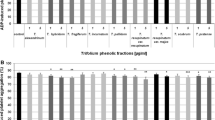Morphofunctional characteristics of human platelets in the presence of 0.1-5 mM ascorbic acid were studied. The platelet ability to form lamellae and the preservation of granules in platelets in suspension and during adhesion were evaluated. Ascorbic acid in concentrations of 0.1-1 mM induced no visible changes in platelet structure and did not affect their adhesion activity, but suppressed lamella growth and degranulation in adherent platelets in a dose-dependent manner. The maximum preservation of granules was revealed in the presence of 0.5 mM ascorbic acid (55% in 1 h from the moment of adhesion). In the presence of 2-5 mM ascorbic acid, spontaneous activation and degranulation of platelets was observed. Thus, ascorbic acid is capable of both suppressing and stimulating platelet activity. In concentrations of 0.5-1 mM ascorbic acid can be used to stabilize granules in adherent platelets.
Similar content being viewed by others
References
Gudkov SV, Bruskov VI, Kulikov AV, Sharapov MG, Kulikov DA, Molochkov AV. The bioantioxidants (part 2). Almanakh Klin. Med. 2014;(31):65-69. Russian.
Tregubova IA, Kosolapova VA, Spasov AA. Antioxidants: current situation and perspectives. Uspekhi Fiziol. Nauk. 2012;43(1):75-94. Russian.
Felfernig-Boehm D, Salat A, Kinstner C, Fleck T, Felfernig M, Kimberger O, Andel H, Mueller MR. Influence of hypotensive and normotensive anesthesia on platelet aggregability and hemostatic markers in orthognathic surgery. Thromb. Res. 2001;103(3):185-192. https://doi.org/10.1016/s0049-3848(01)00316-4
Tyml K. Vitamin C and microvascular dysfunction in systemic inflammation. Antioxidants (Basel). 2017;6(3):49. https://doi.org/10.3390/antiox6030049
Mohammed BM, Sanford KW, Fisher BJ, Martin EJ, Contaifer DJr, Warncke UO, Wijesinghe DS, Chalfant CE, Brophy DF, Fowler AA, Natarajan R. Impact of high dose vitamin C on platelet function. World J. Crit. Care Med. 2017;6(1):37-47. https://doi.org/10.5492/wjccm.v6.i1.37
Shyu KG, Chang CC, Yeh YC, Sheu JR, Chou DS. Mechanisms of ascorbyl radical formation in human platelet-rich plasma. Biomed. Res. Int. 2014;2014:614506. https://doi.org/10.1155/2014/614506
Andreev VN, Evseev AK, Garaeva GR, Goldin MM. Blood serum redox potential and antioxidant activity comparison. Mol. Med. 2013;(4):37-40. Russian.
Murphy DD, Reddy EC, Moran N, O’Neill S. Regulation of platelet activity in a changing redox environment. Antioxid. Redox Signal. 2014;20(13):2074-2089. https://doi.org/10.1089/ars.2013.5698
Borovkova NV, Makarov MS, Andreev YuV, Storozhe-va MV. Tamparing of cytokine content in serum and platelet soluble preparations, produced in different ways. Mol. Med. 2021;19(3):51-57. Russian. https://doi.org/10.29296/24999490-2021-03-08
Makarov MS, Storozheva MV. Morphofunctional properties of human platelets, treated with low doses of hydrogen peroxide. J. Biosci. Med. 2020;8:125-130. https://doi.org/10.4236/jbm.2020.89010
Evseev AK, Pinchuk AV, Goldin MM, Andreev VN. Analysis of the dependency of platinum-electrode open-circuit potential on time in blood serum. Protect. Metals Physic. Chem. Surf. 2014;50(4):553-555. https://doi.org/10.1134/S2070205114040029
Author information
Authors and Affiliations
Corresponding author
Additional information
Translated from Byulleten’ Eksperimental’noi Biologii i Meditsiny, Vol. 174, No. 8, pp. 253-256, August, 2022
Rights and permissions
Springer Nature or its licensor (e.g. a society or other partner) holds exclusive rights to this article under a publishing agreement with the author(s) or other rightsholder(s); author self-archiving of the accepted manuscript version of this article is solely governed by the terms of such publishing agreement and applicable law.
About this article
Cite this article
Makarov, M.S., Storozheva, M.V. Regulation of Human Platelet Adhesion with Ascorbic Acid. Bull Exp Biol Med 174, 280–282 (2022). https://doi.org/10.1007/s10517-023-05690-9
Received:
Published:
Issue Date:
DOI: https://doi.org/10.1007/s10517-023-05690-9



